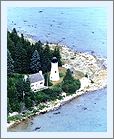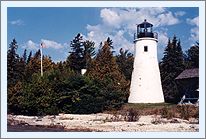|
Historical information

At the dawn of the nineteenth century, the spit of land
protruding from the eastern shore of Lake Huron had already been known
as Presque Isle for over a hundred years, after French trappers seeking
welcome shelter in the natural harbor on the peninsula's southern lee
side gave it the name "almost an island." By 1830 the area
took on additional significance, as steam-powered vessels began stopping
here to stock up on wood to feed their hungry boilers. So important was
this natural harbor of refuge that many an upbound captain decided to
turn tail back to Fort Gratiot finding himself unable to make the safety
of Presque Isle during a gut-busting Nor'wester.
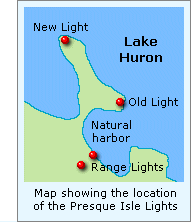 Taking up the call of maritime
interests on February 19, 1838, Michigan State Representative Isaac
Crary beseeched Congress to consider funding the construction of a
lighthouse to guide vessels into Presque Isle harbor. The matter was
referred to the Committee on Commerce, and after receiving a positive
report Congress appropriated the sum of five thousand dollars for the
project on July 7, only five months after Crary introduced his
recommendation. That fall, Lieutenant James T. Homans was dispatched to
select sites for the lighthouse at Presque Isle, along with sites for
other new lights appropriated for Point-aux-Barques, South Manitou
island, New Buffalo and Grassy Island at the foot of Green Bay.
Selecting a slightly elevated area on the point to the northeast of the
harbor that would make the harbor entrance visible to both up and
downbound vessels, Homans drove a stake and marked a number of trees at
the site so that it could be readily identified by the contractor that
would subsequently be chosen to build the station. Taking up the call of maritime
interests on February 19, 1838, Michigan State Representative Isaac
Crary beseeched Congress to consider funding the construction of a
lighthouse to guide vessels into Presque Isle harbor. The matter was
referred to the Committee on Commerce, and after receiving a positive
report Congress appropriated the sum of five thousand dollars for the
project on July 7, only five months after Crary introduced his
recommendation. That fall, Lieutenant James T. Homans was dispatched to
select sites for the lighthouse at Presque Isle, along with sites for
other new lights appropriated for Point-aux-Barques, South Manitou
island, New Buffalo and Grassy Island at the foot of Green Bay.
Selecting a slightly elevated area on the point to the northeast of the
harbor that would make the harbor entrance visible to both up and
downbound vessels, Homans drove a stake and marked a number of trees at
the site so that it could be readily identified by the contractor that
would subsequently be chosen to build the station.
 Bids for the project were let, with
Detroit builder Jeremiah Moors awarded the contract for the station's
construction. With previous experience in lighthouse construction gained
through the construction of the station at Thunder Bay Island in 1832,
Moors' crew arrived at Presque Isle late in 1839, and over the following
year the station's tower and dwelling slowly took shape. In accordance
with specifications, the whitewashed rubble stone tower stood 30 feet in
height with walls four feet thick at the base. The tower stood 18 feet
in diameter at the base, gracefully tapering to a diameter of 9 feet
below the gallery with a hand-cut stone stairway spiraling around the
interior wall of the tower up to the lantern. While we have as yet been
unable to identify the type of lantern and illuminating apparatus
installed, it is likely that the tower was capped with the
birdcage-style lantern and array of Argand lamps with reflectors typical
of towers of the period. The dwelling consisted of a small detached
single story structure located approximately 30 feet inshore from the
tower. Henry L. Woolsey was appointed as the station's first keeper,
officially listed in payroll records as starting service at the station
on September 23, 1840. Bids for the project were let, with
Detroit builder Jeremiah Moors awarded the contract for the station's
construction. With previous experience in lighthouse construction gained
through the construction of the station at Thunder Bay Island in 1832,
Moors' crew arrived at Presque Isle late in 1839, and over the following
year the station's tower and dwelling slowly took shape. In accordance
with specifications, the whitewashed rubble stone tower stood 30 feet in
height with walls four feet thick at the base. The tower stood 18 feet
in diameter at the base, gracefully tapering to a diameter of 9 feet
below the gallery with a hand-cut stone stairway spiraling around the
interior wall of the tower up to the lantern. While we have as yet been
unable to identify the type of lantern and illuminating apparatus
installed, it is likely that the tower was capped with the
birdcage-style lantern and array of Argand lamps with reflectors typical
of towers of the period. The dwelling consisted of a small detached
single story structure located approximately 30 feet inshore from the
tower. Henry L. Woolsey was appointed as the station's first keeper,
officially listed in payroll records as starting service at the station
on September 23, 1840.
After great dissatisfaction with the
administration of lighthouses in the United States, responsibility for
the nation's aids to navigation was removed from the Treasury Department
by an Act of Congress in 1853, and transferred to the newly formed
Lighthouse Board. One of the Board's first orders of business was a
complete upgrading of the Lewis lamps with the superior French Fresnel
lenses. To this end, a work crew arrived at Presque Isle in 1857 and
installed a fixed white Fourth Order Fresnel lens. As was customary in
almost all upgrades of this type, it is likely that the old
birdcage-style lantern was simultaneously replaced by an octagonal cast
iron lantern.
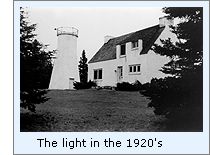 By 1866, the District Inspector
reported that the keepers dwelling was in such poor condition that
nothing short of a complete rebuild would suffice to make the structure
livable, and requested that $7,000 be made available for the work.
Congress approved the requested appropriation on March 2, 1867, and some
of the materials had already been delivered to the site when the
Lighthouse Board suddenly proposed a completely different solution for
the lighting of Presque Isle in its 1868 annual report. Observing that
the combination of the tower's location and diminutive height allowed it
to function only as a harbor light, the Board suggested that an improved
solution for this important area would be to construct a larger light at
the tip of the peninsula approximately a mile to the north, and a pair
of range lights to guide vessels into the harbor itself. The Board
further suggested that with the construction of these new Lights, the
old station would be rendered obsolete, and could thereafter be
extinguished and abandoned. Estimating the cost of construction of such
a coast light to be $28,000 and $7,500 for the ranges, the Board
recommended that the amount be appropriated, and suspended the planned
repairs to the old dwelling pending Congressional action. By 1866, the District Inspector
reported that the keepers dwelling was in such poor condition that
nothing short of a complete rebuild would suffice to make the structure
livable, and requested that $7,000 be made available for the work.
Congress approved the requested appropriation on March 2, 1867, and some
of the materials had already been delivered to the site when the
Lighthouse Board suddenly proposed a completely different solution for
the lighting of Presque Isle in its 1868 annual report. Observing that
the combination of the tower's location and diminutive height allowed it
to function only as a harbor light, the Board suggested that an improved
solution for this important area would be to construct a larger light at
the tip of the peninsula approximately a mile to the north, and a pair
of range lights to guide vessels into the harbor itself. The Board
further suggested that with the construction of these new Lights, the
old station would be rendered obsolete, and could thereafter be
extinguished and abandoned. Estimating the cost of construction of such
a coast light to be $28,000 and $7,500 for the ranges, the Board
recommended that the amount be appropriated, and suspended the planned
repairs to the old dwelling pending Congressional action.
With the appropriation of the necessary
funds in 1869, work on both the Coast Light and Ranges began quickly,
with the Ranges completed at the opening of the 1870 season of
navigation and the New Presque Isle Light station completed in 1871.
Patrick Garraty Sr., who had served as keeper of the old station since
July 15, 1861 moved his wife and four children into the new station, and
exhibited its Third Order Fresnel lens for the first time on the night
of June 1, 1871. With the old light now obsolete, the station's lens and
lantern were removed from the tower and shipped to the Detroit depot for
use elsewhere. With the removal of the lantern, the tower was left
uncapped and the windows and doors to the structures boarded-up to stand
empty and decaying for 26 years until 1897 when the lighthouse
reservation and structures were finally sold at public auction to Edward
O. Avery of Alpena.
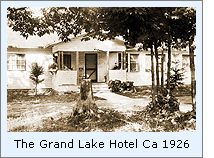 Soon after the turn of the twentieth
century, successful Lansing milliner Bliss Stebbins, and owner of the
nearby Grand Lake Hotel, purchased the property at a tax sale for
$70.00, planning to use the property as a private picnic area for
patrons of his hotel. Bliss was the brother of A. C. Stebbins who had
achieved success as the manager of the Lansing Wheelbarrow Company, and
was one of eight original founders of the Oldsmobile auto company with
Ransom Eli Olds. With the property used only as an extension of the
Grand Hotel, Bliss apparently did nothing to improve either the tower or
dwelling, and by 1930 the building's roof had collapsed, the walls were
crumbling and people were seen stealing bricks to use in their back yard
projects. Soon after the turn of the twentieth
century, successful Lansing milliner Bliss Stebbins, and owner of the
nearby Grand Lake Hotel, purchased the property at a tax sale for
$70.00, planning to use the property as a private picnic area for
patrons of his hotel. Bliss was the brother of A. C. Stebbins who had
achieved success as the manager of the Lansing Wheelbarrow Company, and
was one of eight original founders of the Oldsmobile auto company with
Ransom Eli Olds. With the property used only as an extension of the
Grand Hotel, Bliss apparently did nothing to improve either the tower or
dwelling, and by 1930 the building's roof had collapsed, the walls were
crumbling and people were seen stealing bricks to use in their back yard
projects.
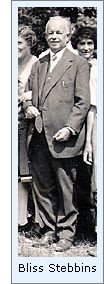 Bliss's brother, Francis B. Stebbins,
purchased the property in 1930, planning to rebuild the dwelling as a
summer cottage for his family, however finding the structure to be
unsalvageable he came to the same decision as the District Inspector
some 70 years previous, deciding to demolish the structure and start
anew. After dynamiting the crumbling walls, Stebbins finished work in
1939, with the structure built in a style reminiscent of an old English
cottage. Bliss incorporated many interesting materials in the
construction, notable among them were the cottage's flagstone floors and
ceiling beams which were salvaged from the old Lansing post office which
was being replaced at the time. With no electricity available on the
property, power was supplied by a 32 volt DC Delco generating plant
located in the cellar. Bliss's brother, Francis B. Stebbins,
purchased the property in 1930, planning to rebuild the dwelling as a
summer cottage for his family, however finding the structure to be
unsalvageable he came to the same decision as the District Inspector
some 70 years previous, deciding to demolish the structure and start
anew. After dynamiting the crumbling walls, Stebbins finished work in
1939, with the structure built in a style reminiscent of an old English
cottage. Bliss incorporated many interesting materials in the
construction, notable among them were the cottage's flagstone floors and
ceiling beams which were salvaged from the old Lansing post office which
was being replaced at the time. With no electricity available on the
property, power was supplied by a 32 volt DC Delco generating plant
located in the cellar.
In the 1940's, Francis purchased a
larger summer home nearby, and continued to use the cottage by the
lighthouse as a guest house. After a number of vacationers began asking
for tours of the old light station, Francis realized that converting the
property into a museum might be a financially rewarding opportunity, and
he set about refurbishing the old tower, which had sustained a
considerable amount of water damage as a result of being uncapped for 70
years. Missing cement was replaced between the stones where it had
washed-out, the structure was given a fresh coat of white paint and a
chain handrail was installed up the center of the stairs at the request
of Stebbins' insurance carrier. Francis heard through the grapevine of an auction being held by the Coast Guard in the
early 1950's, and successfully bid on two Fresnel lenses, which he
brought back to the station. Wishing to install one of them in the
tower, arrangements
were made with a fabricator in Alpena to build a replica octagonal iron
lantern similar to that which was installed on the tower in 1957. The
completed lantern was hoisted atop the tower, and the smaller of the two lenses,
a Fourth Order lens with twin bulls eyes and brass occulting panels was
installed in the lantern.
The old English cottage was furnished
with items appropriate to the mid-nineteenth century period, and various
other maritime artifacts were obtained for display in the cottage and on
the grounds. Electricity finally came to the station in 1965, and
Francis reactivated the light in the tower. However the Coast Guard
would not provide permission for its continued display as a private aid,
and the clockwork rotating mechanism was removed from beneath the lens.
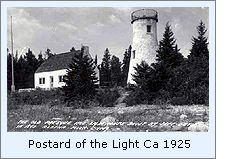 Francis B Stebbins passed away in 1969,
and the property transferred to his son Jim, who continued to operate
the station as a museum. Jim applied for National Register of Historic
Sites status for the station, and the tower being added to the registry
in 1973. Hiring vacationing college girls to serve as guides at the
station, the girls wore nineteenth century period clothes to further the
illusion of a "step back in time." Unfortunately, the college
girls appeared to have acted as a magnet for college boys, and in 1977
Jim made the decision to hire a retired couple George and Loraine Parris
as live-in tour guides and custodians. Francis B Stebbins passed away in 1969,
and the property transferred to his son Jim, who continued to operate
the station as a museum. Jim applied for National Register of Historic
Sites status for the station, and the tower being added to the registry
in 1973. Hiring vacationing college girls to serve as guides at the
station, the girls wore nineteenth century period clothes to further the
illusion of a "step back in time." Unfortunately, the college
girls appeared to have acted as a magnet for college boys, and in 1977
Jim made the decision to hire a retired couple George and Loraine Parris
as live-in tour guides and custodians.
The second Fresnel lens purchased in
the 1950's was displayed in the cottage. Mounted on wheels, it was
rolled out onto the patio on sunny days, where it shone like a huge
piece of jewelry. Unfortunately, Jim became aware that this was not the
best way to display the lens, as the litharge began to break down and
the glass segments became loose, and the lens thereafter remained on
display in the cottage. Soon after the Charlevoix School District
obtained ownership of the Beaver Head Light station in 1979, a
representative of the District approached Jim, inquiring if he might be
interested in selling them the lens for installation in the Beaver Head
tower. Jim decided to donate the lens, and it was packaged-up and
shipped to Beaver Island where it is displayed to this day at the base
of the tower.
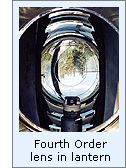 George Parris passed away in 1992, and
Lorraine continued to serve as the custodian. As a result of increasing
taxes and insurance costs, Jim Stebbins sold the property to the State
of Michigan to be incorporated into the State Park, and donated the
structures to the Township in 1995. The Township Historical Society
continues to operate the lighthouse as a museum to this day from May
through October. The museum is open seven days a week from 9 a.m. To 6
p.m. George Parris passed away in 1992, and
Lorraine continued to serve as the custodian. As a result of increasing
taxes and insurance costs, Jim Stebbins sold the property to the State
of Michigan to be incorporated into the State Park, and donated the
structures to the Township in 1995. The Township Historical Society
continues to operate the lighthouse as a museum to this day from May
through October. The museum is open seven days a week from 9 a.m. To 6
p.m.
Local lore reports that the deactivated light in the tower has been
seen illuminated at night, and many believe that George Parris returns to reactivate
it, but that is a story of a type on which we are unqualified to
comment.

Keepers of
this Light

Click here
to see a complete listing of all keepers of the Presque Isle Old Light
compiled by Phyllis L. Tag of Great Lakes Lighthouse Research.

Finding this Light

Take US23 South from Rogers City, and turn east on 638 Hwy/Highway Road.
Continue to the point at which the road splits, and take the left fork
when the road splits, staying on 638 Hwy. Continue for approximately 2
miles, and turn North on Grand Lake Road. Continue approximately one
mile until you reach the shore of the Lake. Continue North for 1/4 mile,
and the entrance to the lighthouse park is on the right. Park in one of
the spaces between the trees, and walk to the end of the point to the
lighthouse.

Contact information

Old Presque Isle Lighthouse
5295 Grand Lake Road
Presque Isle, MI 49777
(989) 595-2787

Reference Sources

 Congressional
records, various Congressional
records, various
Annual
reports of the Fifth Auditor of the Treasury, 1838 - 1952, various.
Annual
reports of the Lighthouse Board, 1852 - 1897, various
Inventory of Historic
Light Stations, National Parks Service, 1994
Northern Lights, Charles K Hyde, 1995
Interview with Jim Stebbins, Monday March 25, 2002.
Aerial photograph courtesy of Marge Beaver of Photography Plus
Personal observation at Presque Isle, 09/11/1998
Photographs from the author's personal collection.
Historic photographs from the Michigan State Archives.
Keeper listings for this light appear courtesy of Great
Lakes Lighthouse Research
|
